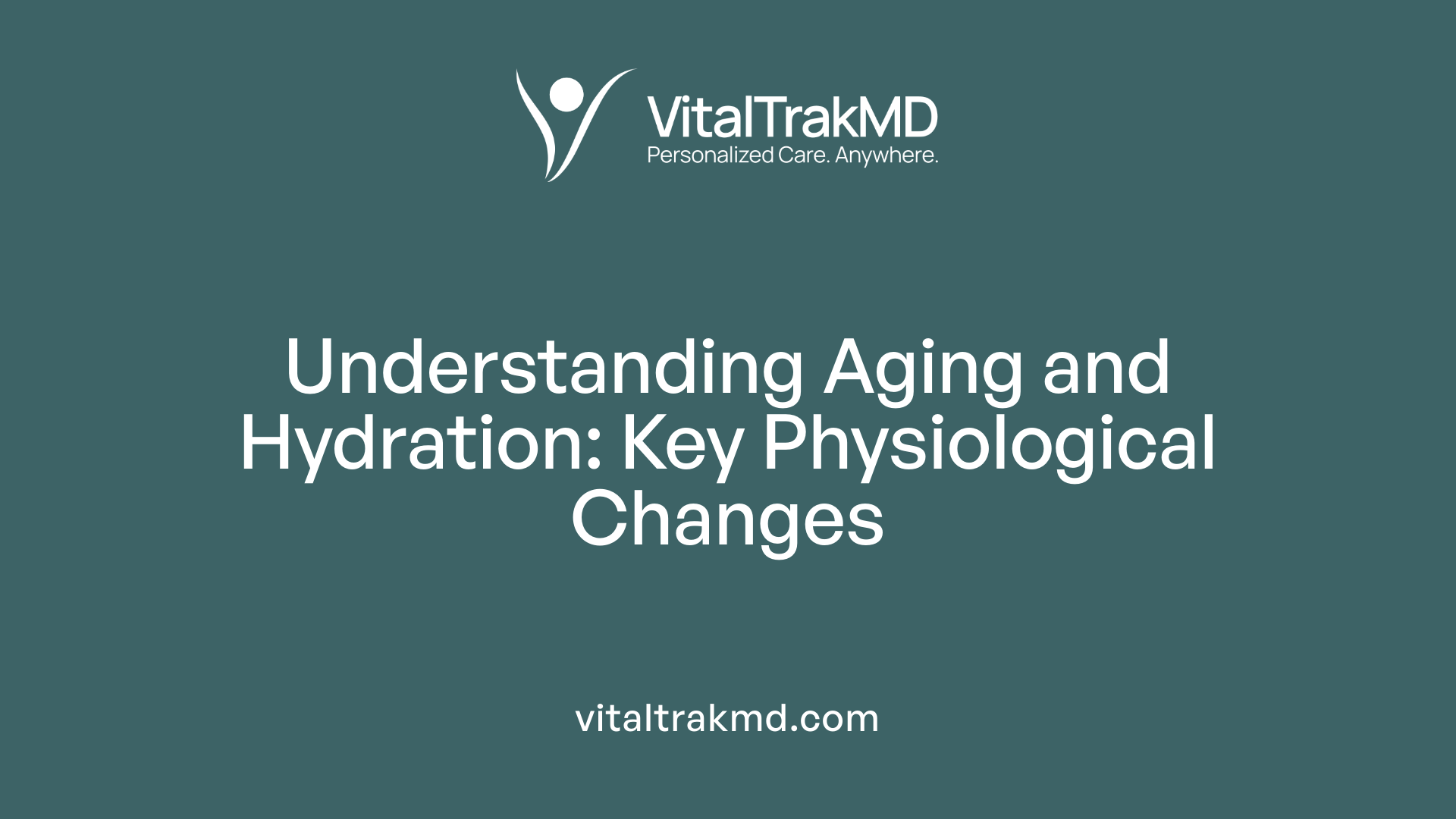Supporting Seniors With Effective Hydration Strategies

Understanding the Vital Role of Hydration in Senior Health
Hydration is a fundamental aspect of maintaining health and well-being, particularly among seniors. As people age, physiological and behavioral changes naturally diminish thirst sensation and water reserves, making effective hydration strategies indispensable for supporting health, preventing complications, and promoting quality of life for older adults.
Physiological Influences on Hydration in Older Adults

Why is hydration important for seniors and their overall health?
Hydration plays a vital role in maintaining overall health, especially among older adults. As people age, their bodies become less efficient at conserving water and regulating temperature, heightening the risk of dehydration.
Older adults rely on adequate hydration to support essential functions like digestion, joint lubrication, and kidney health. Proper water intake helps prevent serious health issues, including urinary tract infections, kidney stones, and heat-related illnesses such as heat stroke.
Additionally, hydration contributes to maintaining cognitive functions, mood, and energy levels. When dehydrated, seniors may experience confusion, fatigue, or dizziness, which can compromise safety and independence.
Many seniors manage chronic illnesses or take medications like diuretics that increase fluid loss. Their diminished thirst sensation means they often do not recognize when they need more fluids.
Hence, understanding age-related physiological changes affecting hydration is crucial. Strategies like regular drinking routines, eating water-rich foods, and using reminders can support their health and improve quality of life.
Age-related changes in body composition affecting water content
With age, total body water content decreases significantly. Young adults typically have about 60% of their body weight as water, but this drops to around 50-55% in seniors.
This decline is mainly due to reduced lean muscle mass and increased body fat. Muscle tissue holds more water than fat, so as muscle decreases, so does water retention.
The distribution of water also shifts, with less water available intracellularly and extracellularly, impairing the body's ability to maintain hydration during stress or illness.
Decreased thirst sensation and hormonal regulation
Older adults experience a diminished sense of thirst due to changes in the brain's thirst centers. This leads to fewer drinking cues, making them less likely to seek out fluids.
Hormonal regulation of water balance also changes with age. For example, vasopressin (or antidiuretic hormone, ADH), which helps the kidneys conserve water, becomes less responsive.
These physiological changes mean that seniors are less aware of their hydration needs and less capable of conserving water effectively, increasing dehydration risks.
Impaired renal function and water conservation issues
Aging kidneys undergo structural and functional alterations, such as decreased nephron number and reduced glomerular filtration rate.
These changes impair the kidneys' ability to concentrate urine and conserve water, making older adults more susceptible to dehydration.
Consequently, even mild illnesses or hot weather can cause significant fluid loss with slower recovery.
Understanding these physiological impacts underscores the importance of proactive hydration strategies tailored for seniors.
| Aspect | Change with Age | Impact on Hydration | Recommended Action |
|---|---|---|---|
| Body water content | Decreases from ~60% to 50-55% | Less total water available, faster dehydration | Encourage water-rich foods; regular drinking routines |
| Thirst sensation | Diminishes | Less awareness of dehydration | Use reminders and cues to drink fluids |
| Kidney function | Declines in filtration and concentration ability | Slower water conservation, increased dehydration risk | Monitor hydration, ensure adequate fluid intake |
By recognizing these age-related shifts, caregivers and seniors can work together to maintain proper hydration and prevent dehydration-related health complications.
Risks and Signs of Dehydration in the Elderly
 Dehydration presents serious health risks for older adults, including kidney failure, urinary tract infections (UTIs), and heat-related illnesses like heat stroke. It can also lead to confusion, falls, and a decline in overall health, significantly increasing hospitalization and mortality rates. Recognizing the signs early is crucial for prevention.
Dehydration presents serious health risks for older adults, including kidney failure, urinary tract infections (UTIs), and heat-related illnesses like heat stroke. It can also lead to confusion, falls, and a decline in overall health, significantly increasing hospitalization and mortality rates. Recognizing the signs early is crucial for prevention.
Common indicators of dehydration in seniors include dry mouth, dark urine, and infrequent urination. They may also display symptoms like dizziness, fatigue, dry skin, and confusion, which can sometimes progress to more severe disorientation or difficulty breathing. In extreme cases, dehydration can cause loss of consciousness or pale, bluish skin.
Several factors contribute to the higher risk of dehydration among older adults. Medications such as diuretics and laxatives increase fluid loss. Chronic conditions like diabetes impair fluid balance. Additionally, age-related physiological changes diminish thirst sensation and kidney function, making it harder for the body to conserve water. Cognitive impairments and mobility issues may also hinder regular fluid intake.
Caregivers should stay vigilant for these signs and promote consistent hydration through regular offering of fluids. Monitoring episodes of confusion or dizziness and maintaining hydration routines can prevent severe complications. Consulting healthcare providers is advisable for personalized strategies, especially for seniors with chronic illnesses or medication use that raises dehydration risk. Immediate medical attention is critical if severe symptoms such as disorientation, difficulty breathing, or loss of consciousness occur.
More about dehydration symptoms and risks in the elderly can be found through healthcare resources and geriatric care guidelines, emphasizing early detection and prevention.
Effective Hydration Strategies for Seniors

What strategies can be used to effectively hydrate seniors and support proper fluid intake?
Maintaining proper hydration is crucial for seniors, as aging bodies become less efficient at conserving water and sensing thirst. To help older adults stay well-hydrated, several practical strategies can be implemented.
One effective approach is establishing consistent routines for drinking fluids. For example, caregivers can encourage seniors to drink water or other hydrating beverages after waking up, during meals, and after physical activities. Sipping small amounts regularly throughout the day is often more successful than attempting to drink large quantities at once, especially since many older adults experience diminished thirst sensation.
Making hydration appealing can improve adherence. Adding natural flavors like lemon, berries, or cucumber slices to water can make it more enticing, encouraging increased intake. Providing easy access to water bottles or pitchers—placed in visible, convenient locations—removes barriers and prompts regular drinking.
Incorporating foods with high water content is another effective strategy. Fresh fruits such as watermelon, strawberries, and oranges, as well as vegetables like cucumbers, zucchini, and lettuce, can significantly contribute to daily fluid intake naturally.
Limiting drinks that promote dehydration, such as alcohol and caffeinated beverages, is also essential, especially in hot weather or during illness. These can interfere with fluid balance and exacerbate dehydration.
Healthcare professionals can offer personalized hydration advice tailored to individual health conditions, mobility, and medication use. Using reminders—such as alarms, hydration apps, or visual cues like colorful water bottles—can further support consistent fluid intake.
In sum, combining routine, flavor, accessibility, hydration-rich foods, and professional guidance creates an effective strategy to ensure seniors maintain adequate hydration and avoid dehydration-related health issues.
Practical Tips for Caregivers and Healthcare Providers
What practical tips can caregivers and healthcare providers follow to promote proper fluid intake among the elderly?
Promoting hydration in older adults requires a proactive and personalized approach. Caregivers and healthcare providers should regularly offer fluids throughout the day, ensuring that drinks are easily accessible and appealing. Tailoring hydration plans to individual needs involves considering factors such as chronic health conditions, medication use, and mobility limitations.
Using a variety of strategies can significantly improve fluid intake. For example, providing flavored waters with natural herbs or fruits can make drinking more enjoyable. Including water-rich foods like cucumbers, watermelon, strawberries, soups, smoothies, and cooked vegetables helps boost hydration naturally.
Establishing consistent routines, such as offering a glass of water with each meal or before bed, encourages regular drinking habits. Reminders via visual cues—like colorful water bottles or hydration posters—and drink trackers can help those with decreased thirst sensation remember to hydrate.
Monitoring hydration status closely is essential. Signs like dark urine, dizziness, confusion, or dry mouth should prompt immediate intervention. Caregivers should be vigilant for these indicators and act promptly, whether by encouraging more fluids or seeking medical advice.
Educational efforts are equally important. Teaching older adults why staying hydrated matters, along with understanding symptoms of dehydration, can motivate behavioral change. Creating an environment that supports hydration—such as providing water stations in common areas and integrating hydration into daily activities—further promotes well-being.
By combining these practical strategies, caregivers and healthcare professionals can help reduce dehydration risks, improve health outcomes, and enhance quality of life for older adults.
Assessing and Managing Hydration in Elderly Patients
How is hydration status assessed and managed in elderly populations?
Monitoring hydration in older adults is crucial due to their higher vulnerability to dehydration-related health issues. Health professionals often use a combination of clinical evaluations and laboratory tests to accurately determine hydration status.
Serum osmolality is considered the most reliable laboratory indicator. When levels rise above 300 mOsm/kg, it typically signals dehydration. Alongside serum measurements, urine tests such as specific gravity and osmolarity assist in assessing how well the kidneys are conserving water. These tests help identify if the body is adequately hydrated or if fluid deficits exist.
Physical signs like skin turgor and dry mucous membranes, commonly used in younger populations, are less dependable in seniors because aging skin and mucosal changes can mask dehydration symptoms. Therefore, additional tools such as clinical screening questionnaires and hydration assessment protocols are often utilized.
Given that older adults tend to have a diminished sense of thirst, altered renal function, and physiological alterations in water regulation, it is essential to incorporate routine monitoring of urine output and signs like confusion, dizziness, or fatigue.
Management of hydration involves creating personalized plans that consider individual health status, mobility, and preferences. These plans typically include encouraging regular water and beverage intake, with particular attention to water-rich foods like fruits and vegetables. In cases of severe dehydration, healthcare providers may administer oral rehydration solutions or intravenous fluids.
Preventative strategies are equally important. Education for caregivers and patients about the signs of dehydration, maintaining accessible hydration sources, and timely interventions can significantly reduce the risks.
In summary, assessing hydration in the elderly requires a multifaceted approach, combining biochemical tests with clinical evaluation, to enable tailored, effective management aimed at minimizing complications and improving quality of life.
Scientific Support for Hydration Interventions in Seniors

Are there recent scientific studies or research findings that support specific hydration interventions for seniors?
Recent research highlights the importance of tailored hydration programs to prevent dehydration-related health issues among older adults. Studies suggest that personalized approaches—which take into account individual health status, medication use, and body composition—are more effective in maintaining proper hydration.
Monitoring tools like serum osmolality tests are considered gold standards for assessing hydration levels. Regular hydration assessments help identify seniors at risk early on, enabling timely intervention.
In addition to assessments, interventions such as encouraging water-rich foods like fruits and vegetables, establishing consistent routines to remind seniors to drink, and improving access to beverages are supported by scientific evidence.
Research also advocates for the use of hydration tracking devices, educational programs, and staff training in care environments. These strategies collectively contribute to better hydration practices and health outcomes.
Overall, current studies endorse the integration of individualized hydration plans, routine assessments, and practical strategies to effectively support the hydration needs of the elderly, reducing the risk of dehydration and its serious health consequences.
Conclusion: Prioritizing Hydration for Healthy Aging
 Maintaining proper hydration is essential for seniors as it supports vital bodily functions such as kidney health, digestion, joint lubrication, and temperature regulation. Adequate water intake helps prevent serious health conditions like UTIs, heat stroke, and cardiovascular problems, which are more common with age. Since older adults often experience diminished thirst sensation and physiological changes that impair water conservation, they are at higher risk of dehydration.
Maintaining proper hydration is essential for seniors as it supports vital bodily functions such as kidney health, digestion, joint lubrication, and temperature regulation. Adequate water intake helps prevent serious health conditions like UTIs, heat stroke, and cardiovascular problems, which are more common with age. Since older adults often experience diminished thirst sensation and physiological changes that impair water conservation, they are at higher risk of dehydration.
Effective strategies like consuming water-rich foods, using reminders, and fostering social hydration routines are crucial. Monitoring hydration through signs like dark urine, confusion, or fatigue allows prompt intervention. Healthcare systems and caregivers must stay vigilant by providing education, routine assessment, and personalized hydration plans.
Ongoing education and careful monitoring can significantly reduce dehydration-related morbidity and hospitalization. Caregivers play a vital role by offering regular fluids, facilitating easy access to water, and observing early signs of dehydration. Expanding awareness about hydration importance supports healthier aging, improves quality of life, and prevents avoidable health complications. Prioritizing hydration remains a simple yet powerful measure to promote well-being among the elderly.
Sustaining Hydration: A Collective Responsibility for Elderly Well-being
Ensuring adequate hydration among seniors is a collaborative effort involving caregivers, healthcare providers, and policy makers. Through personalized assessment, education, routine monitoring, and the incorporation of water-rich foods and appealing beverages, we can significantly reduce dehydration risks. Continued research and innovative tools are vital for refining hydration interventions and promoting a culture of preventative care. By actively supporting seniors in maintaining optimal hydration, we contribute to their overall health, independence, and enhanced quality of life, fostering a more resilient aging society.
References
- How to Stay Hydrated: A Guide for Older Adults
- Interventions to Improve Hydration in Older Adults
- Importance of Hydration for Seniors
- Hydration Status in Older Adults: Current Knowledge and ...
- Wet Your Whistle with Water (W3) to Improve Water Intake ...
- Hydration Tips for Seniors: Why It Matters More with Age
- 6 Effective Ways to Prevent Dehydration in Seniors
- 10 Reasons Why Hydration is Important
Recent articles
Want to Feel Better and Live Healthier?
Join hundreds of patients taking control of their health with personalized care that fits their life – not the other way around.
Rated 4.8/5 by 32+ customers







